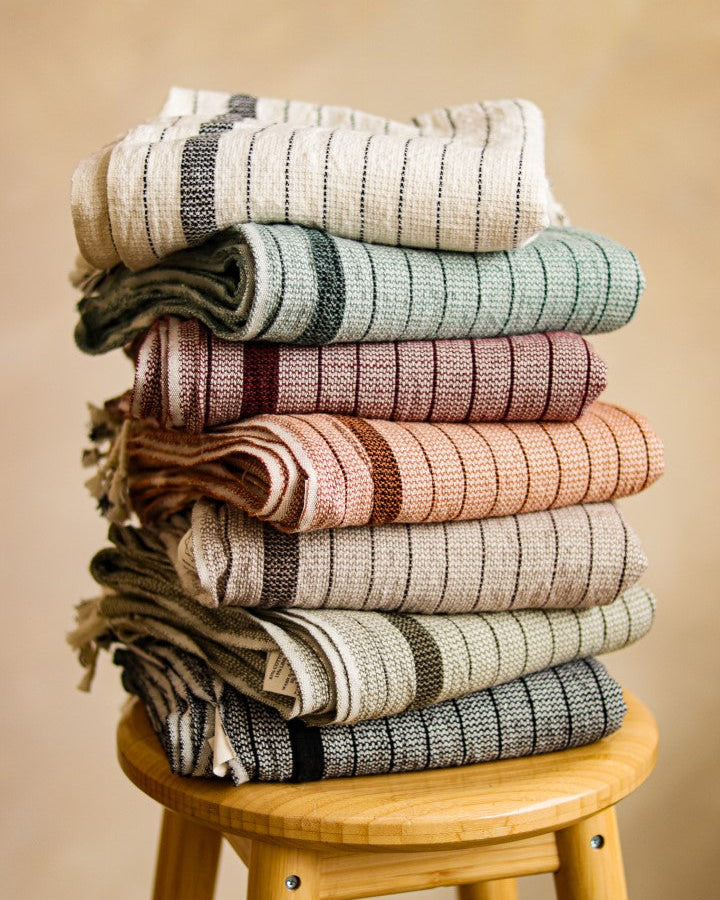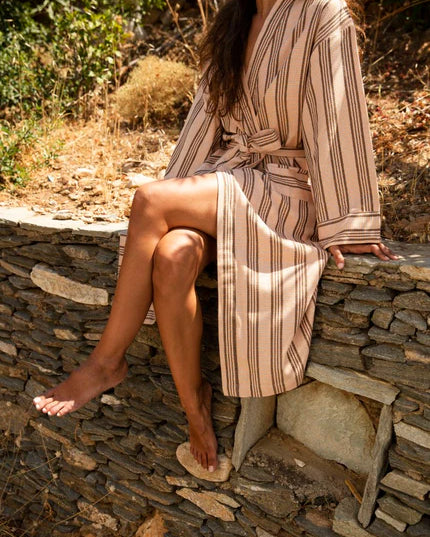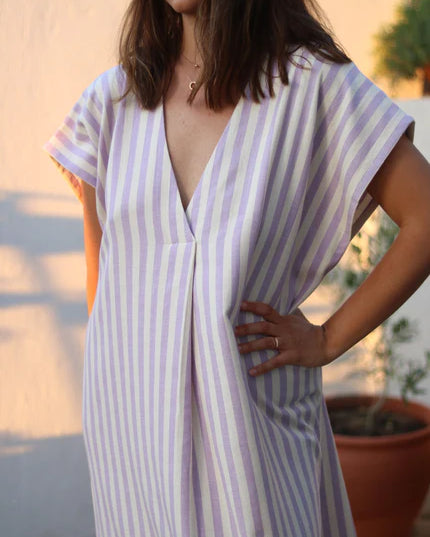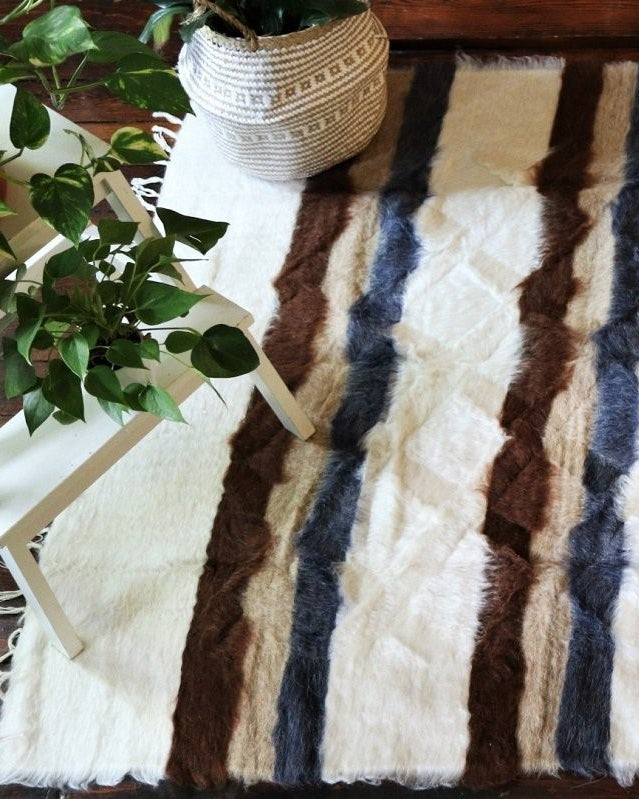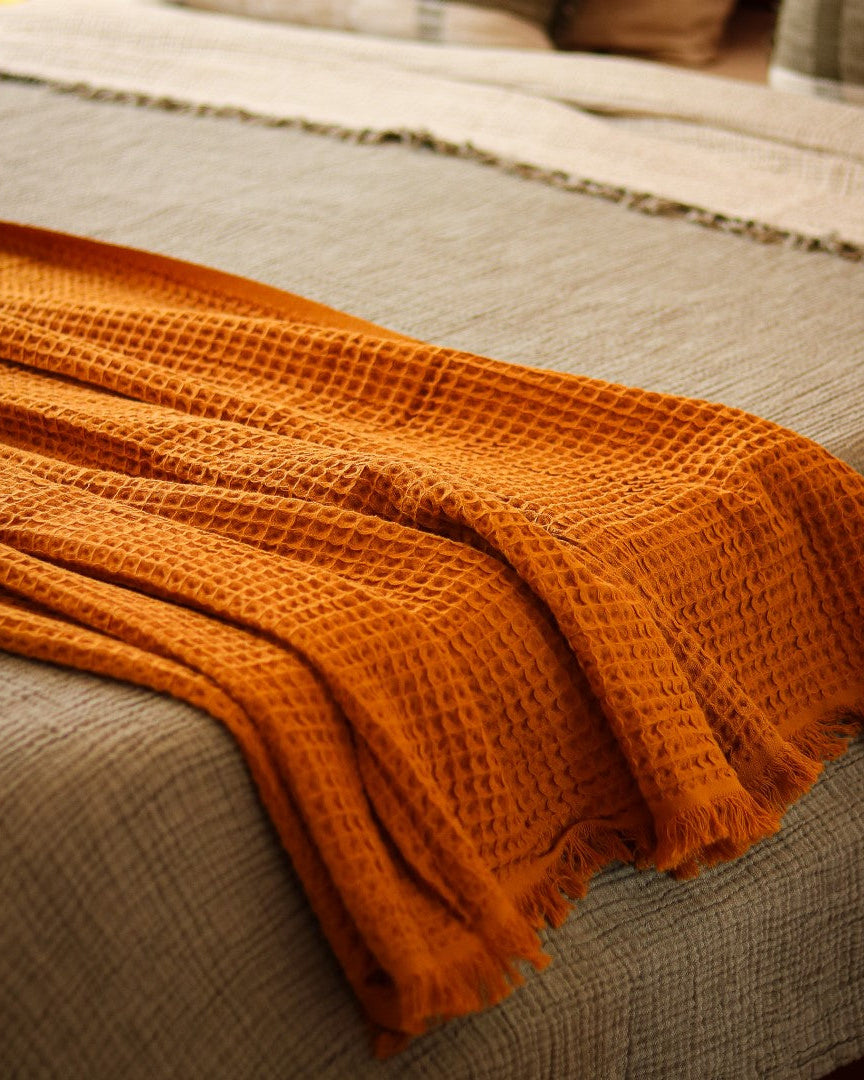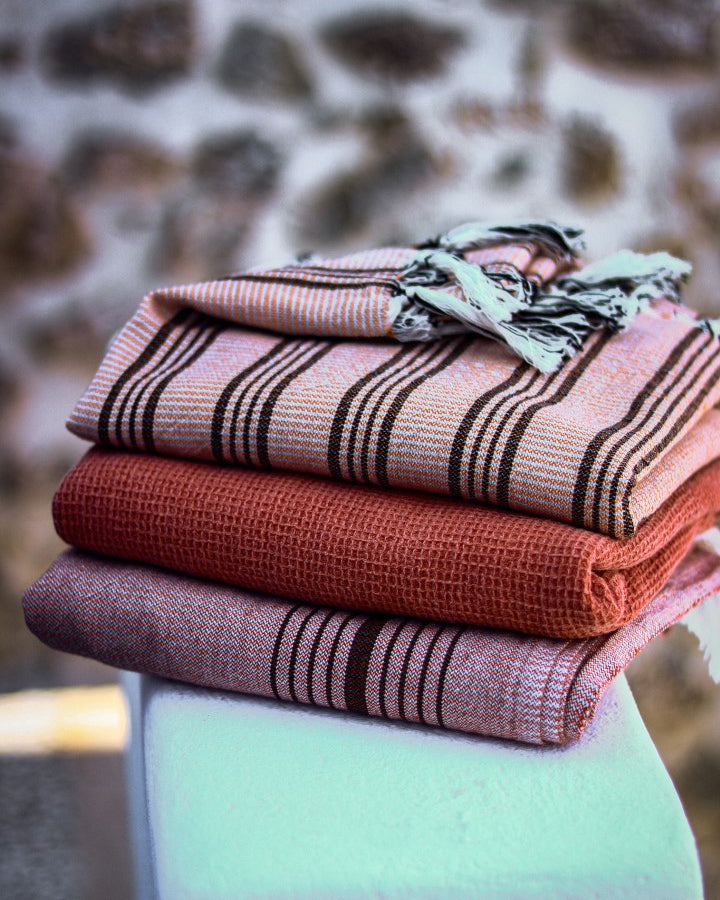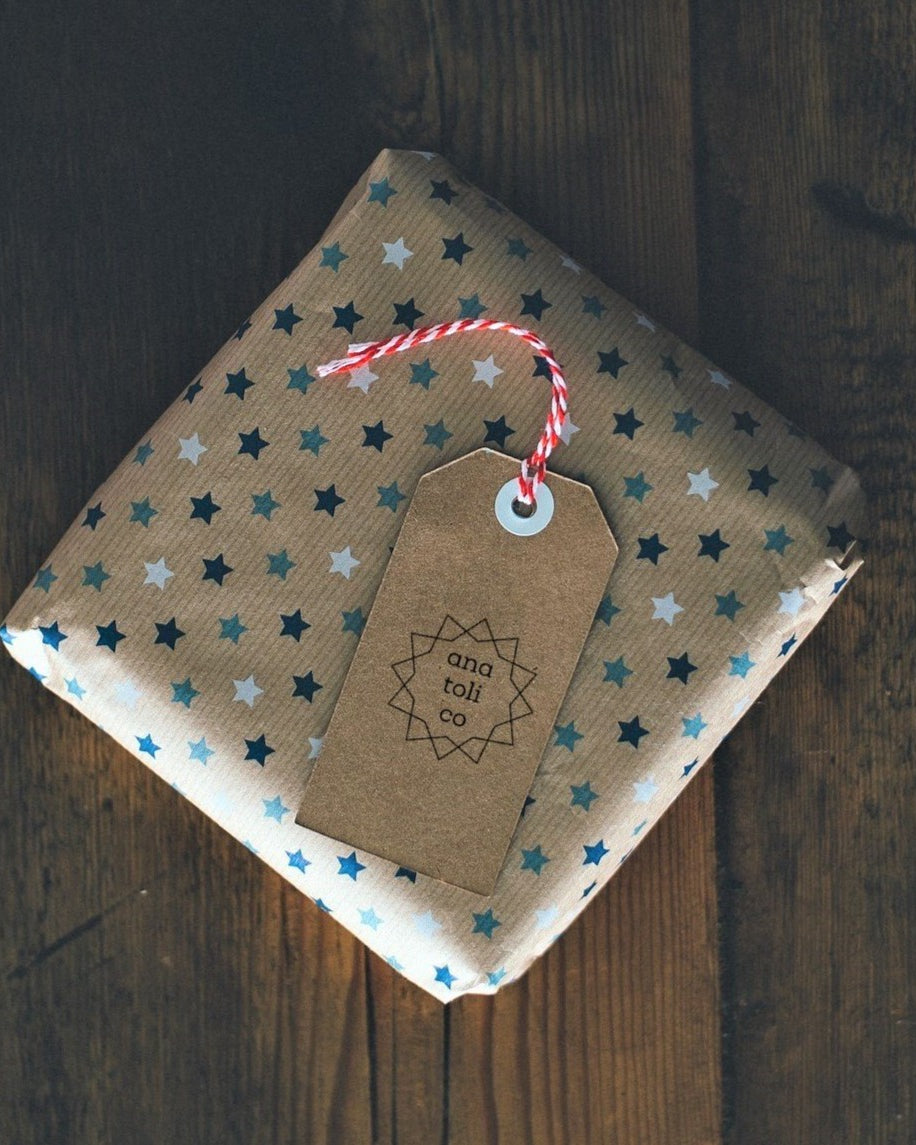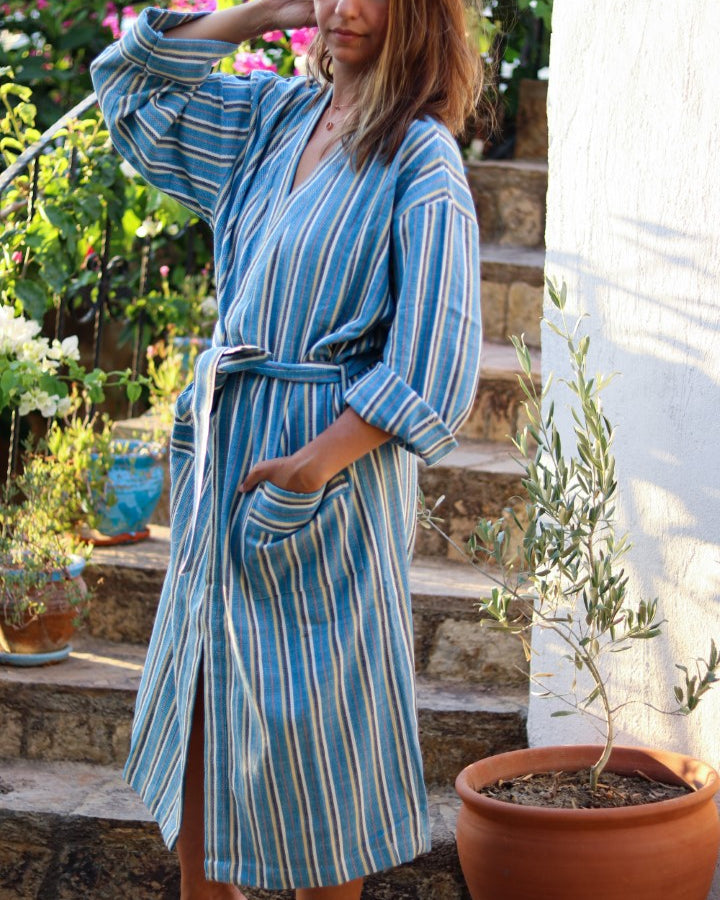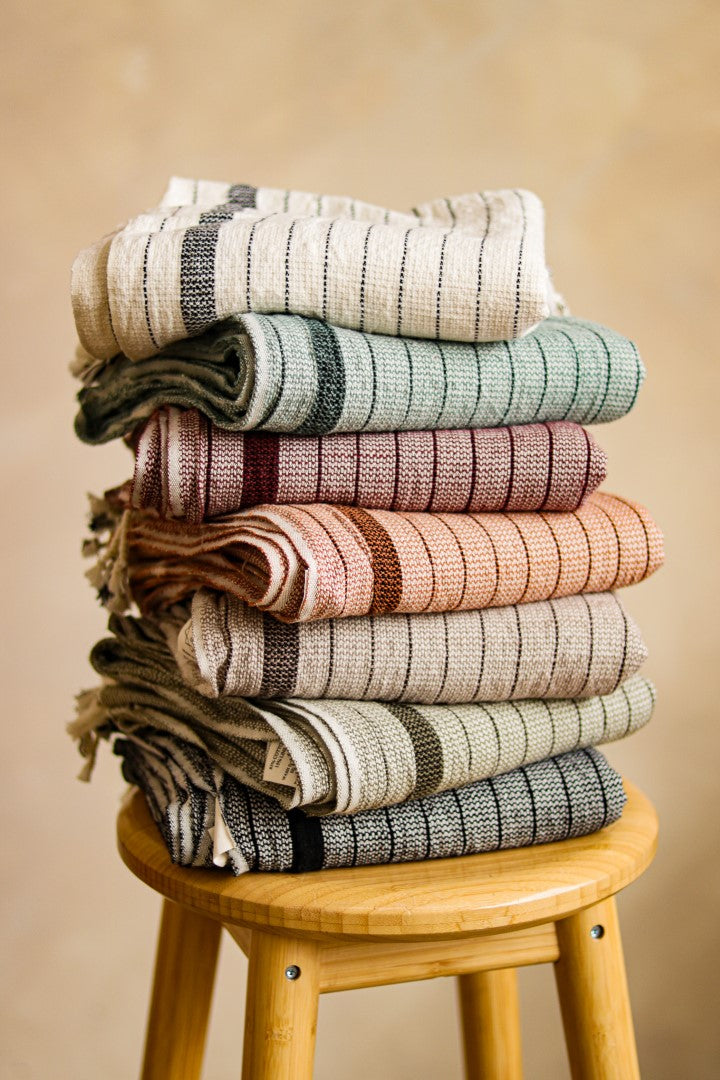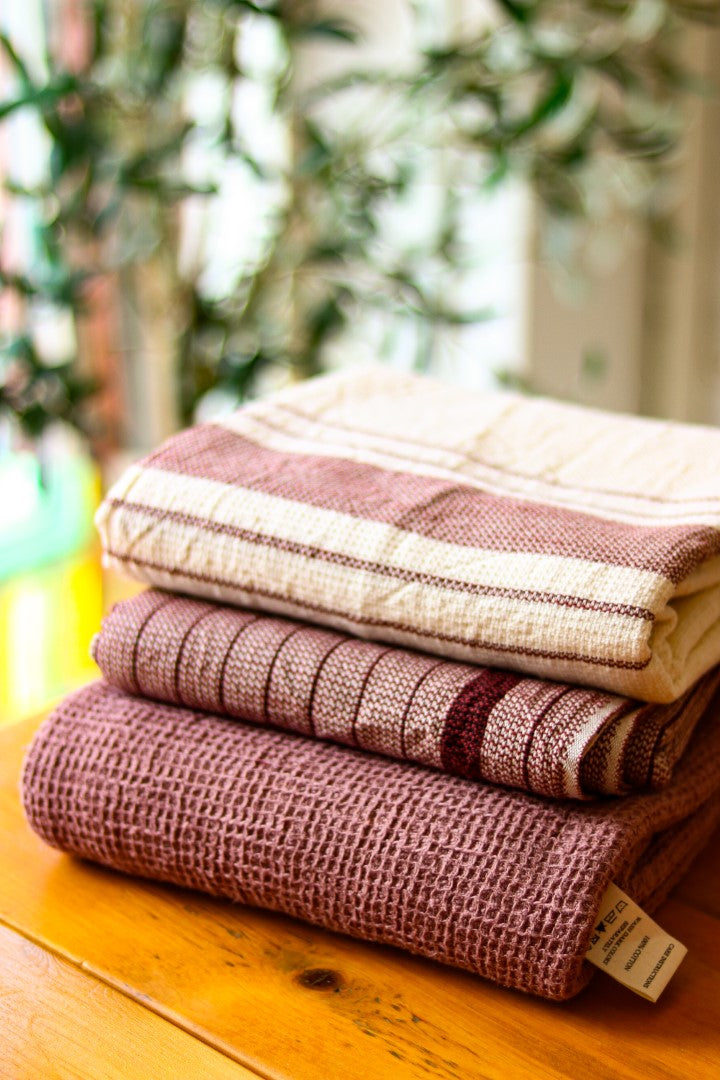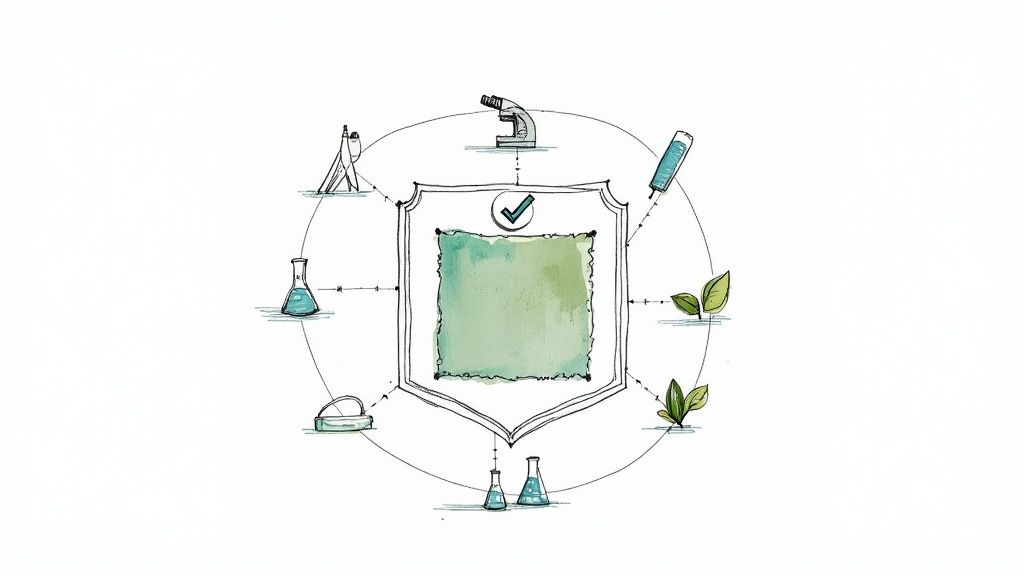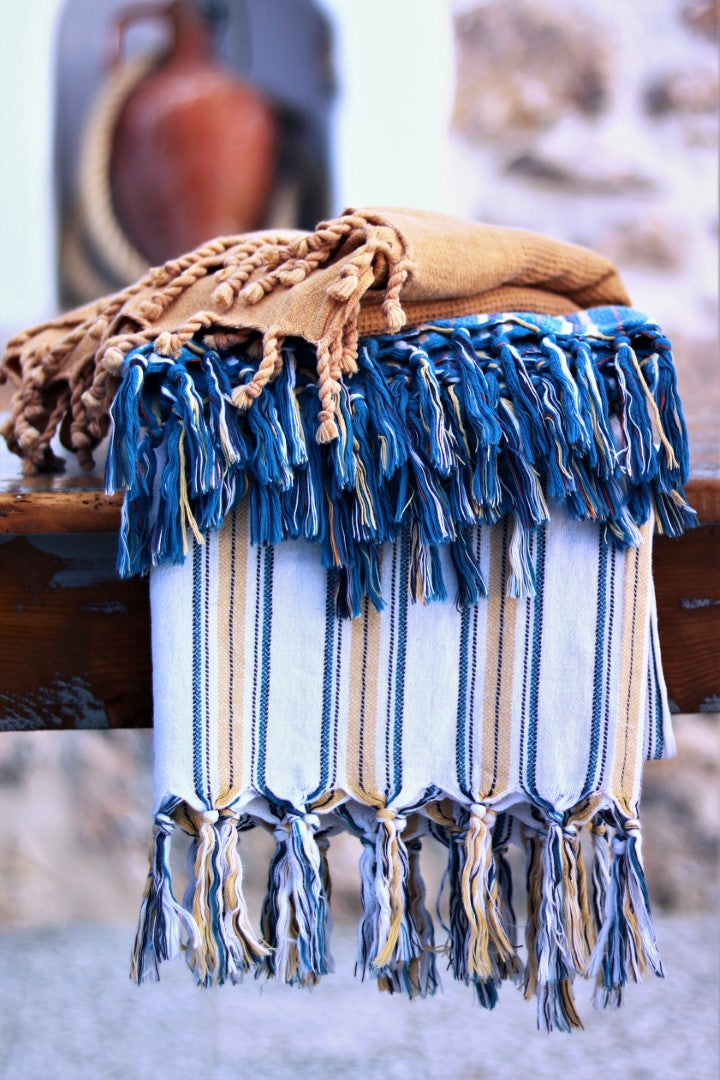When you see a tag on a textile product, the OEKO-TEX certified meaning is actually quite simple: it’s a mark of safety. Think of it as a comprehensive health check for your fabrics. It assures you that every single component—from the thread and fabric to the buttons and zippers—has been rigorously tested and found free from a list of over 350 harmful substances.
What an OEKO-TEX Label Guarantees

The OEKO-TEX label is far more than just a marketing slogan; it represents a globally recognized, independent testing and certification system. At its core, it promises that a textile product is safe for human health. This isn't just a surface-level check, either. The certification process examines every last detail of a product to ensure it's clear of chemicals known to be detrimental to you and your family.
This consumer-first approach has made it a leading benchmark for textiles worldwide. The growing demand for transparency is undeniable. In a single recent financial year, the association issued over 57,000 certificates, an 8% increase from the previous period. This surge reflects a powerful industry-wide shift toward credible, verifiable safety data.
A Promise of Purity and Protection
Imagine a protective shield between your skin and potentially harmful chemicals. That’s essentially the role the OEKO-TEX STANDARD 100 certification plays. It's designed to give you peace of mind, especially when you're choosing products that come into close contact with your body, like towels, bedding, and clothing.
For a quick overview, here's what the certification really means for you.
OEKO-TEX STANDARD 100 At a Glance
| Key Aspect | What It Means for You |
|---|---|
| Comprehensive Testing | Every component of the item, from threads to buttons, is tested. |
| Harmful Substance Free | The product is free from over 350+ regulated and non-regulated chemicals. |
| Beyond Legal Requirements | The testing criteria are often stricter than national and international laws. |
| Global Standard | It's a consistent, reliable standard recognized and trusted worldwide. |
| Human-Ecology Focus | The tests are based on how the product will be used, with stricter limits for items touching the skin. |
This table shows just how thorough the process is. The certification provides real assurance against a wide range of potential hazards.
What Does OEKO-TEX Test For?
The testing is incredibly detailed, covering substances you might not even think about. It specifically provides assurance against:
- Harmful Dyes: It screens for carcinogenic and allergenic colorants that can cause skin irritation or more severe health issues.
- Pesticides and Heavy Metals: Residues from farming (like pesticides) and manufacturing (like lead, arsenic, or cadmium) are strictly limited or banned altogether.
- Regulated & Unregulated Chemicals: The testing criteria often go beyond existing laws, proactively banning substances that are scientifically suspected of being harmful, even if they aren't legally regulated yet.
The essential promise of the STANDARD 100 label is simple: if it bears this certification, you can be confident that the product has been tested for harmful substances and is therefore harmless for human health.
Ultimately, the OEKO-TEX certified meaning boils down to trust. It’s a reliable signal that the brand you're buying from has invested in making sure its products are safe for you. To learn even more, this article explains what OEKO-TEX Standard 100 truly entails and why it matters.
Cracking the Code: The Four Product Classes of STANDARD 100
When it comes to textile safety, OEKO-TEX doesn't take a one-size-fits-all approach. Instead, the STANDARD 100 system is built on a simple, brilliant principle: the more a product touches your skin, the tougher the testing it has to pass.
This logic makes perfect sense. It ensures the highest level of safety right where it matters most, creating a tiered system that divides textiles into four distinct product classes. Each class has its own specific limits for harmful substances, tailored to how we actually use these items in our daily lives.
Product Class 1: The Gold Standard for Babies
This is the strictest class of them all, and for good reason. It covers every textile item made for babies and toddlers up to three years old, from their onesies and bedding to their soft toys.
A baby's skin is incredibly sensitive and their immune system is still developing, so the safety bar here is set exceptionally high. Every thread, button, and zipper is scrutinized against the most demanding criteria. They even test for colorfastness when exposed to saliva, guaranteeing that no harmful dyes can leach out if a baby mouths the fabric.
Product Class 2: Items Touching Your Skin
This is the category for textiles that spend a lot of time in direct contact with your skin. Think about the products you wear and use every single day.
A few common examples include:
- Bed Linens: The sheets and duvet covers you wrap yourself in every night.
- Clothing: Your favorite t-shirts, blouses, and underwear.
- Towels: Absorbent essentials like Anatolico's Turkish towels, which are meant to be soft and safe against your skin after a shower.
The testing for this class is still incredibly stringent to protect you from any harmful substances during prolonged, daily contact.
Product Class 3: Minimal to No Skin Contact
As we move to the outer layers, we find Product Class 3. This group is for textiles that have very little, if any, direct contact with your body.
The central idea here is practicality. A heavy winter coat simply doesn't need to meet the same intense safety requirements as a newborn's pajamas. This tailored approach makes the OEKO-TEX certification both scientifically sound and relevant for real-world use.
Typical items in this class are jackets, coats, and some types of lining materials. While the testing is still comprehensive, the limits are adjusted for the lower risk of anything transferring to your skin.
Product Class 4: Furnishings and Decorative Materials
Finally, we have the class for decorative and furnishing materials. These are the textiles that fill our homes and workspaces but aren't really meant to touch our skin.
This category includes things like:
- Curtains and drapes
- Tablecloths
- Upholstery fabrics
- Carpets
Even though you’re not wearing them, these items are still tested to ensure they don't release harmful chemicals into the air you breathe. It’s all about creating a healthier indoor environment. This thoughtful classification is a huge part of what makes the OEKO-TEX certification so trusted by people all over the world.
The Science Inside the OEKO-TEX Label
When you see a textile tagged as "tested for harmful substances," it’s your cue that a deep, scientific process has taken place—one that goes far beyond a simple surface check. The true oeko tex certified meaning is anchored in a massive catalog of tests, meticulously screening every single product component for more than 350 individual chemicals.
This isn’t just about the main fabric, either. Independent labs put everything under the microscope. We’re talking about the sewing threads, the buttons, the zippers, and even the dyes used for prints and coatings. Every last piece has to pass these demanding criteria on its own before the final product can ever earn its certification.
Going Beyond Legal Requirements
One of the things that makes the STANDARD 100 so powerful is that its requirements often go way beyond what’s legally mandated by national and international laws. Governments might regulate a handful of known chemicals, but OEKO-TEX takes a much more proactive stance on keeping you safe. They actively test for and restrict substances that are scientifically suspected of being harmful, even if they haven't been officially banned yet.
This puts a wide range of potential health hazards on their watchlist:
- Banned Azo Dyes: These are specific colorants that have the potential to release carcinogenic compounds.
- Heavy Metals: Nasty stuff like lead, cadmium, and mercury are kept to incredibly strict limits.
- Pesticides: Any lingering residues from the agricultural side of things are carefully tested and controlled.
- Formaldehyde: A chemical often used in textile finishing that’s a known skin irritant for many people.
This forward-thinking approach means the certification stays ahead of the curve, constantly adapting as new scientific research comes to light. It’s a living standard.
A Holistic Testing Philosophy
The real genius of the testing process is that it’s designed to mimic how we actually use textiles in our daily lives. For example, labs don't just check if a chemical is present; they test whether it could be transferred to your skin through contact with sweat or saliva. It’s this practical, human-focused perspective that gives the certification its true value.
At its heart, the promise is simple: the entire finished product is harmless to human health. It’s a complete guarantee that no single part of that product—no matter how small—will expose you to something dangerous.
The infographic below breaks down the different product classes, which determine just how strict the tests are based on how close the item gets to your skin.
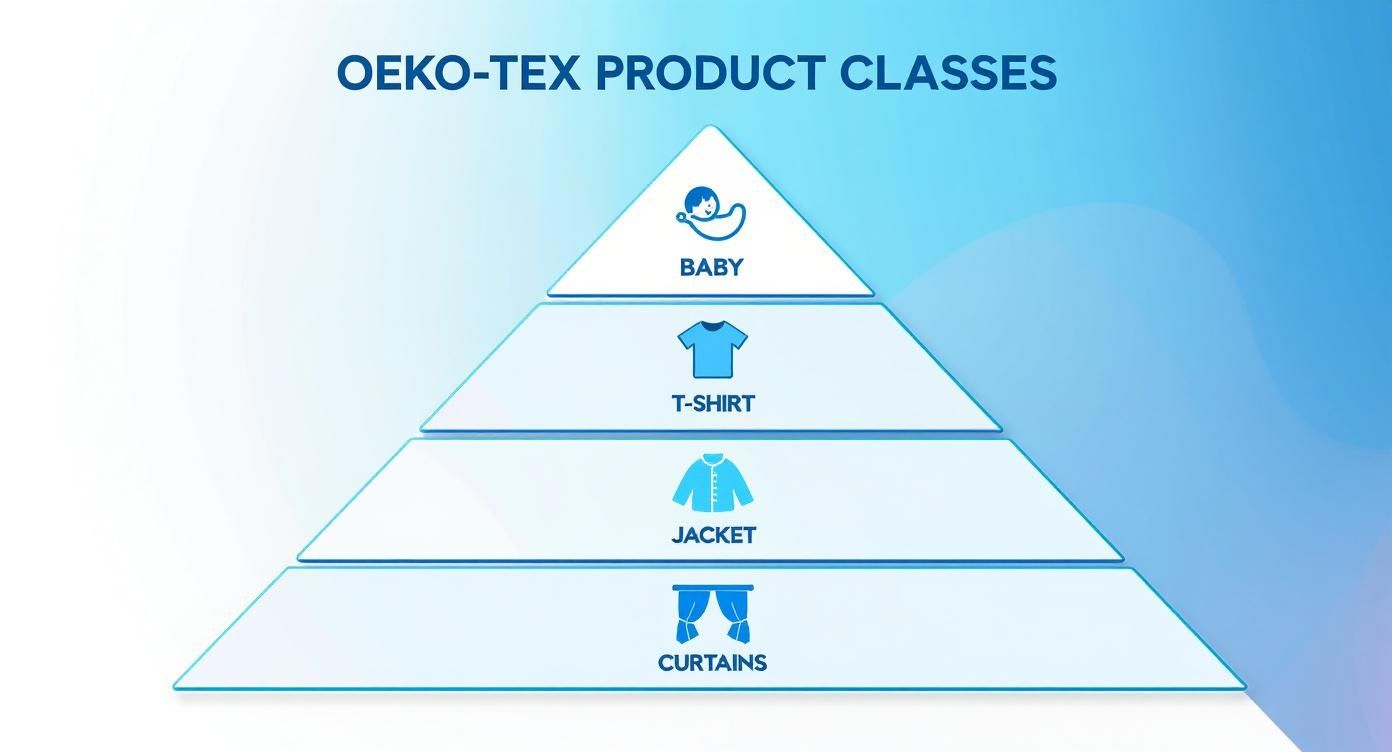
As you can see from the pyramid, items made for babies (Class 1) have to meet the absolute toughest standards. Makes sense, right? On the other end, decorative materials (Class 4) have more lenient, though still protective, requirements. This tiered system ensures the highest level of safety is applied exactly where it counts the most, making the OEKO-TEX certified meaning a reliable and dynamic seal of approval for you and your family.
Why This Certification Matters for Your Health
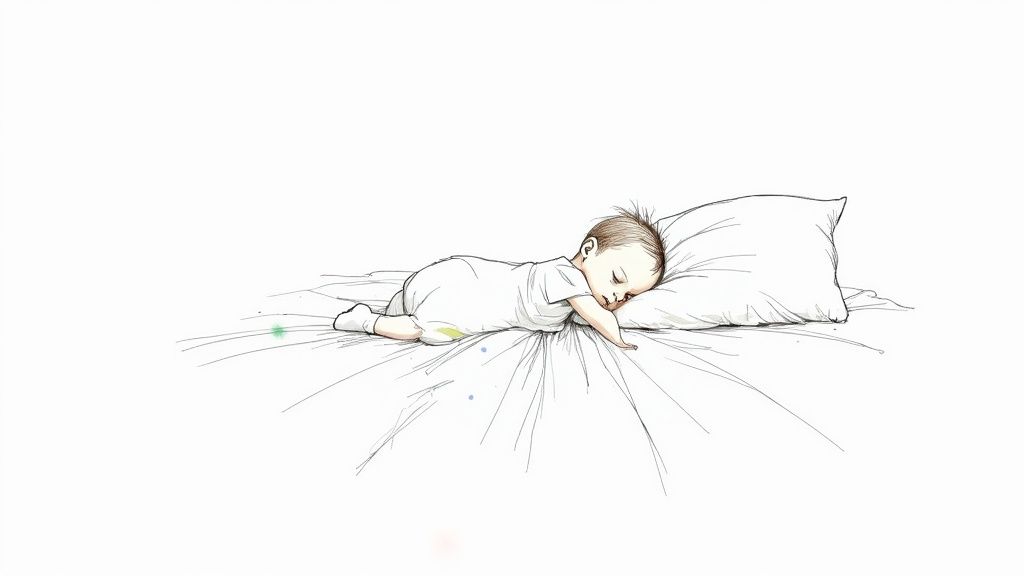
The science behind the OEKO-TEX label is impressive, but what does it really mean for you and your family at home? Simply put, it's about peace of mind. It's the confidence that comes from knowing the fabrics touching your skin are genuinely safe, creating a healthier environment where it counts most.
Think about it for a moment. From the towel you grab after a shower to the sheets you sleep in all night, textiles are a constant part of our lives. Without certification, these items can harbor residual chemicals from the production line—things like formaldehyde, heavy metals, or allergenic dyes. Over time, exposure to these substances can lead to anything from nagging skin irritation to more serious health concerns.
A Shield for Sensitive Skin
This assurance is absolutely crucial for the most vulnerable among us. Babies and young children have thinner, more absorbent skin, which makes them far more susceptible to irritation from chemical residues.
When you choose a product that meets the strict Product Class 1 criteria, you know it's safe enough for an infant. That same logic extends to anyone with sensitive skin or conditions like eczema, where avoiding potential triggers is a daily priority.
By selecting OEKO-TEX certified items, you are actively reducing your family's daily exposure to a long list of potentially harmful chemicals. It's a simple, proactive step toward creating a safer personal environment.
A Healthier Indoor Environment
The benefits don't stop at your skin. Many textiles are treated with chemicals that can release volatile organic compounds (VOCs) into your home’s air, a process known as off-gassing. These invisible emissions can degrade indoor air quality and may lead to headaches or respiratory issues.
Because OEKO-TEX certified products have strict limits on these chemicals, they contribute to a cleaner, healthier atmosphere inside your home. This is especially important in bedrooms and living areas, where we spend the bulk of our time.
Ultimately, this certification is the bridge between responsible manufacturing and your personal well-being. It’s the proof that the beautiful textiles you bring into your home—like a soft, absorbent cotton towel—are not just a pleasure to use but are also fundamentally safe.
Of course, knowing the source material is just as important. You can learn more by exploring how eco-friendly cotton can be in our detailed guide. Choosing certified products is a conscious decision to put your family’s health first, every single day.
Going Beyond Safety with Other OEKO-TEX Labels
While STANDARD 100 is the label you'll see most often, it's really just the tip of the iceberg. The full meaning behind OEKO-TEX certified textiles goes much deeper, covering the entire journey from raw material to the finished product you bring home.
Think of it as a complete ecosystem of certifications. It acknowledges that a truly responsible product isn't just about what's in it, but also how it was made. While STANDARD 100 checks the final item for safety, other labels pull back the curtain on the entire production process. This gives you the power to choose products that align not just with your family's health, but with your environmental and social values, too.
STeP: Certifying the Factories
One of the most powerful labels in the system is STeP, which stands for Sustainable Textile and Leather Production. Instead of testing a towel or a t-shirt, STeP puts the factory itself under the microscope. It's essentially a rigorous report card for the entire facility, grading it on six core modules:
- Chemical management
- Environmental performance
- Environmental management
- Social responsibility
- Quality management
- Health and safety
When a factory earns a STeP certification, it proves a serious commitment to environmentally friendly processes and safe, fair working conditions for its people. It's the behind-the-scenes assurance that the manufacturing is as clean and ethical as the final product is safe.
And it's not a static checklist. As the world’s priorities evolve, so does STeP. For example, recent updates have sharpened the focus on sustainable sourcing and the protection of natural habitats, tackling the issue of biodiversity loss head-on. You can read more about the latest STeP requirements to see how the standard is constantly pushing the industry forward.
MADE IN GREEN: The All-in-One Label
This brings us to MADE IN GREEN, which is probably the most comprehensive and transparent consumer label OEKO-TEX offers. It neatly bundles the assurances of the other certifications into a single, powerful seal.
A product carrying the MADE IN GREEN label is a triple promise. It guarantees the item is tested for harmful substances (STANDARD 100), produced in an environmentally friendly facility (STeP certified), and manufactured under safe and socially responsible working conditions.
What's really incredible is the transparency. Every MADE IN GREEN label has a unique product ID or a QR code. You can scan it or enter the ID on the OEKO-TEX website to trace the product's entire lifecycle, seeing the different factories and countries involved in bringing it to life. This is next-level accountability.
So, when you're shopping for something like the best organic cotton towels, spotting that MADE IN GREEN label means you're not just getting a safe, high-quality product—you're supporting a better way of making it.
How to Verify Any OEKO-TEX Label in Seconds
You've spotted a product with an OEKO-TEX label. That’s a great start, but in a world full of greenwashing, how can you be sure it's the real deal?
Thankfully, OEKO-TEX has made this incredibly easy. They have an official online tool that lets you check any label's authenticity in seconds, so you can personally confirm the oeko tex certified meaning for yourself.
Every genuine OEKO-TEX label has a unique certificate number printed right on it. Think of this number as a specific tracking ID that links directly back to the official database.
You can instantly look it up by visiting the OEKO-TEX Label Check website. It’s a free tool that gives you immediate peace of mind by showing the certificate’s status and all the relevant details.
Your Step-by-Step Verification Guide
Putting this into practice is simple. The next time you're out shopping or even just checking a textile you already own, follow these steps.
-
Find the Label Number: First, locate the OEKO-TEX label on the product’s tag or packaging. You’re looking for a unique certificate number, which is usually a multi-digit code often listed alongside the name of the testing institute.
-
Go to the Label Check Tool: Open up your browser and head to the official OEKO-TEX Label Check portal. A quick search for "OEKO-TEX Label Check" will get you there.
-
Enter the Certificate Number: Carefully type the complete number into the search box on the website and hit the "Check" button.
The system will instantly search its database and pull up the results. If the certificate is valid, you'll see all the details: the type of certification (like STANDARD 100), the product class it falls under, and exactly what articles the certificate covers. If the number is fake or expired, the tool will tell you right away.
This simple process empowers you. It turns you from a passive shopper into an informed buyer, allowing you to cut through any misleading claims and be confident that you're getting the safety and quality promised by a genuine certification.
Common Questions About OEKO-TEX Certification
Even after getting the basics down, it's totally normal to have a few lingering questions. The OEKO-TEX system is pretty thorough, so let's break down some of the most common points of confusion you might run into when looking at product tags.
Getting these details straight helps you see exactly what OEKO-TEX promises and how it makes the textiles in your home safer. It’s all about becoming a more confident shopper who can see through the marketing noise.
Is OEKO-TEX the Same as Organic?
This is probably the number one question people ask, and it's a great one. The short answer is no, OEKO-TEX and organic are not the same thing, but they work beautifully together. Think of them as covering different stages of a product's life.
- Organic is all about how the raw materials were grown. For a cotton plant, this means no synthetic pesticides, no GMOs, and no artificial fertilizers. It's purely an agricultural standard.
- OEKO-TEX STANDARD 100, on the other hand, zooms in on the finished product. It tests the final towel, robe, or blanket you hold in your hands for a huge list of potentially harmful chemicals used during manufacturing—things like dyes, softeners, and other finishing agents.
You could have a towel made from 100% organic cotton that was later treated with harsh, irritating dyes. Conversely, a synthetic fabric that was never "grown" at all can still earn the OEKO-TEX label if it’s proven to be free from harmful substances.
The ideal scenario? A product that is both organic and OEKO-TEX certified. That gives you peace of mind from the farm to your home, which is especially important for anyone trying to find the best towels for sensitive skin.
Does an OEKO-TEX Certificate Expire?
Yes, it absolutely does. This isn't just a one-time checkup; it's an ongoing commitment to safety. Every single OEKO-TEX certificate is only valid for 12 months.
This annual renewal process is what gives the label its teeth. It forces manufacturers to stay on top of their game and meet the latest standards. The list of banned substances is reviewed and updated every year based on new scientific research and global regulations. This ensures the certification you see today reflects today's safety knowledge, not last decade's.
The limited validity of the certificate is a powerful consumer protection measure. It ensures that the OEKO-TEX certified meaning remains a trustworthy and up-to-date indicator of product safety, year after year.
Is a STANDARD 100 Product Eco-Friendly?
Not automatically. The STANDARD 100 label is first and foremost about human health. Its main job is to confirm that the final product is safe for you and your family to touch.
While keeping hundreds of nasty chemicals out of the production process obviously has some great environmental benefits, the STANDARD 100 doesn't look at the factory's water usage, carbon footprint, or social conditions.
If you're looking for a label that guarantees both product safety and a responsible manufacturing process, you'll want to seek out the OEKO-TEX MADE IN GREEN certification. This is a much broader label, confirming the item is not only tested for harmful substances but was also produced in an environmentally friendly and socially responsible facility.
At Anatolico, we believe in transparency and safety, which is why our textiles are OEKO-TEX certified. Explore our collection of thoughtfully crafted Turkish towels and home goods at https://www.anatolico.co.

